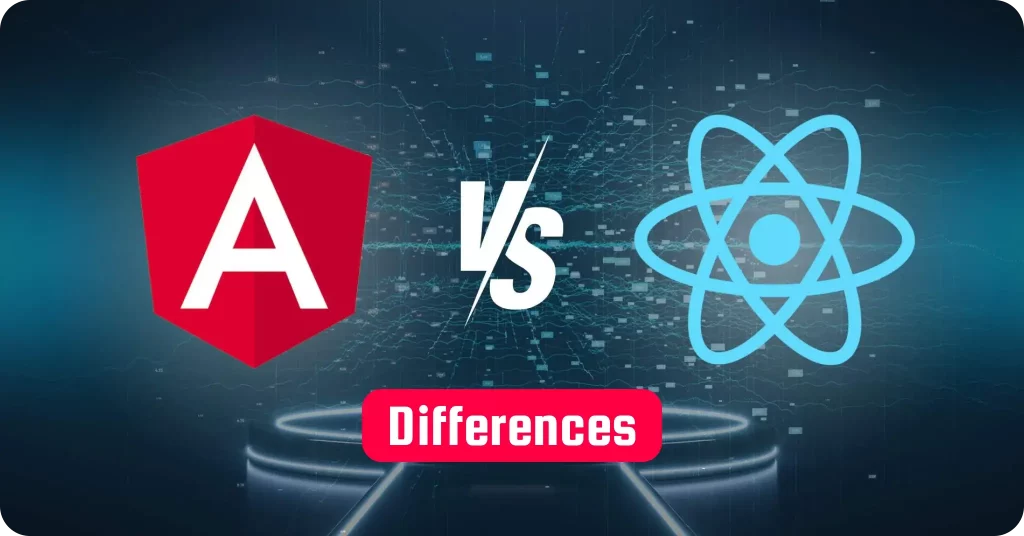Key Takeaways
- Curious to know the main difference between Angular and React?
- This blog aims to answer just that question and explores some of their differences by looking at learning curves, architectural philosophies, performance, community support, & tooling differences.
Introduction
Angular and React are the top common choices when front-end development starts. So when developers have a tough time choosing between the two, understanding the main difference between Angular and React helps them make the right decision. If you are thinking of developing a web app, consider hire dedicated ReactJS developers so you have the right resources to take care of your development requirements. Learn about the two frameworks and their various use cases below.
Overview of Angular and React
Knowing the main difference between Angular and React will be helpful in understanding which one you should consider for your next app development.
| Angular | React |
| a. A full-featured, comprehensive framework developed by Google. | a. JavaScript library developed by Facebook for creating UIs. |
| b. Provides a full solution to create complex web apps. | b. Focuses only on the “view” layer, unlike Angular. |
| c. It includes many built-in features, making it a complete and ready-to-use option. | c. Offers flexibility and reusability with its component-based approach. |
1. Architectural Philosophy
The architectural philosophy of Angular and React is one of their most crucial differences. Here, we explain how each tool approaches software design and development.
Angular: Full-Stack Framework
Being a complete full-stack framework, Angular provides all the needed tools to build a web app.
- Dependency Injection: This feature allows developers to manage dependencies efficiently, which makes components easier to test.
- Two-Way Data Binding: Angular keeps the data synchronized between the model and the view, which can be useful but may impact performance in large applications.
- Directives: Angular extends HTML capabilities with its powerful directives, enabling custom behavior in the UI.
Angular is ideal for projects that need a comprehensive, integrated solution following a structured, opinionated approach.
React: View Library
React takes a different path by focusing solely on the “view” part of the application:
- Virtual DOM: It makes rendering faster by updating only the changed parts of the DOM.
- Component-Based Architecture: With React, developers create user interfaces from reusable components that manage their own state.
- One-Way Data Binding: This allows data to flow in a single direction, simplifying the debugging process & making data flow easier to understand.
By encouraging flexibility and allowing developers to use third-party libraries for a lot os different functionalities, React allows easy ReactJS app building by combining various apps tailored to specific needs.
2. Learning Curve and Complexity
The learning curve for Angular and React varies significantly due to their structural and technological choices. In this section, we explore the complexity involved in mastering each tool.
Angular: Steeper Learning Curve
Angular’s comprehensive nature means a steeper learning curve:
- TypeScript Usage and Build Setup: Angular uses TypeScript, which can make it more challenging for developers unfamiliar with it.
- Key Concepts: Angular developers must understand dependency injection, decorators, and modules, adding to the overall complexity.
React: Gentle Learning Curve
React offers a relatively gentler learning experience:
- Familiarity with JavaScript: React mainly uses JavaScript, making it approachable for developers with JS experience.
- Complexity Through Third-Party Libraries: As a project grows, React requires developers to incorporate libraries for routing, state management, etc., which can add complexity. For example, developers may need to learn how to receive event data from the back-end using a WebSocket.
3. Performance and Efficiency
Performance is an important factor to consider when deciding between Angular & React. Here, we discuss how each handles performance in web applications.
Angular: Robust but Potentially Heavy
Large-scale apps with data-bound components might experience performance issues because Angular’s two-way data binding and digest cycle can slow things down. Additionally, without careful management, Angular’s change detection can create bottlenecks.
React: Optimized Rendering
React’s virtual DOM helps minimize direct manipulation of the real DOM, improving performance and offering a more responsive user experience. This makes React ideal for scenarios where optimized rendering is critical.
4. Community and Ecosystem
The community and ecosystem behind Angular and React shape the level of support and resources available to developers. Here, we explore how each tool’s community influences development.
Angular: Stable with Strong Corporate Support
Backed by Google, Angular has a lot of stability & reliability. It has a large, mature ecosystem with many tools, libraries, and resources available. However, Angular’s strict adherence to its own conventions leaves less room for customization compared to React.
React: Vibrant and Growing Community
Supported by Facebook, React has a lot of frequent updates, good community support, as well as a good set of ReactJS third-party libraries and tools. These tools help developers build static sites, create simple API calls, and so on.
5. Tooling and Development Experience
Tooling greatly affects the developer’s experience and productivity. This section discusses how Angular and React differ in terms of development tools and setups.
Angular: Integrated Tools
Angular CLI provides a powerful set of tools for scaffolding, development, and testing. It includes built-in tools that streamline project setup and maintenance, making the development experience straightforward.
React: Flexible Tools
While React doesn’t have a built-in CLI like Angular, the ecosystem offers various tools and libraries for development. Create react app is a popular choice for bootstrapping projects. React also provides developers the freedom to choose their preferred tools and setup, offering flexibility. Many third-party tools can help level up your ReactJS web development.
Conclusion
The choice between Angular and React comes down to your project’s specific needs:
- Angular is perfect if you want a complete, integrated framework with strong tools and a structured setup.
- React is ideal for developers who prefer flexibility, a component-based approach, and the ability to mix and match third-party tools.
If you need to develop a web application and want a dedicated team, consider hiring ReactJS developers who can efficiently bring your vision to life. For companies or projects that require flexibility and scalability, knowing the main difference between Angular and React would help you decide on the right path.
Soft Suave is one of the top IT web app development companies, experienced in various tech stacks, including ReactJS. Choosing the right tech partner like Soft Suave can help you build robust and scalable applications that meet your requirements.

Jayasin Prabhu is the Assistant Manager – Projects, known for his strategic vision and leadership in project management. With expertise in full-stack technologies like JavaScript, React, Angular, Node.js, Express.js, and MongoDB, he excels in driving efficiency and delivering top-notch results.


